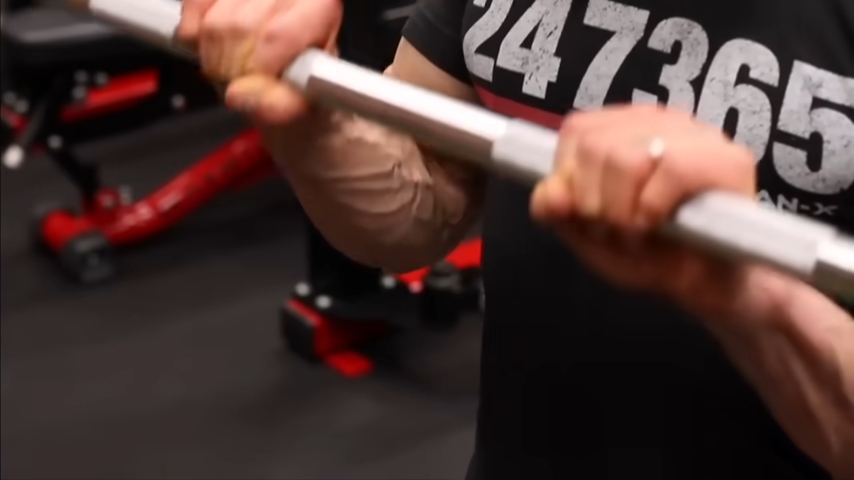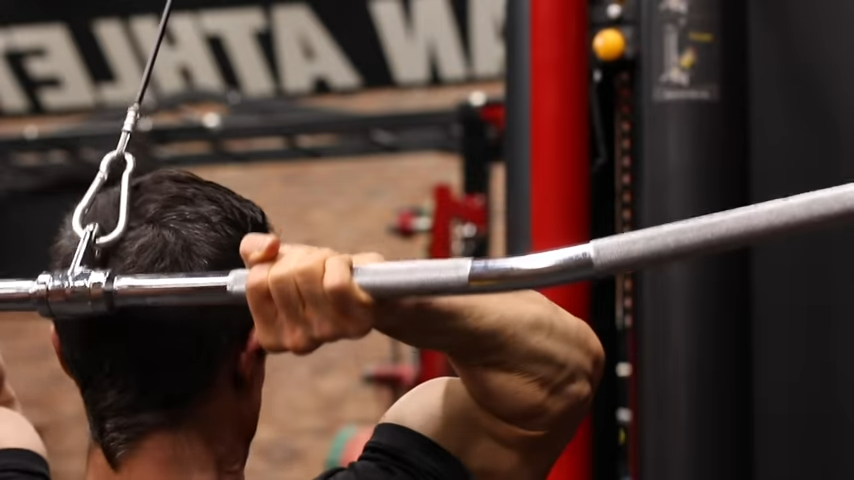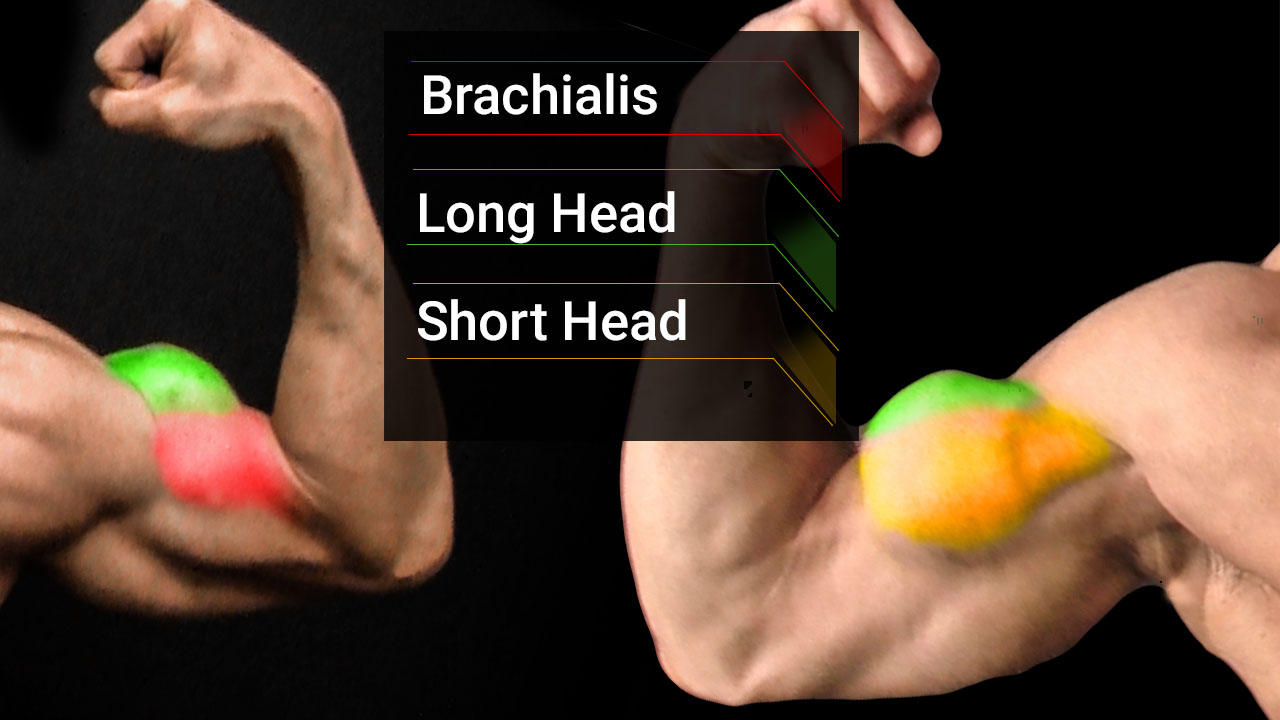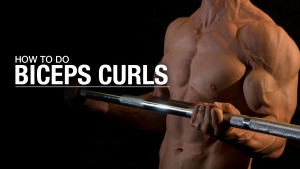
REVERSE CURLS FOR BIGGER THICKER ARMS
If you’re skipping Reverse Curls in your workouts, you’re leaving serious gains on the table.
This isn’t just another arm curl. It turns your forearms into steel and unlocks killer grip strength.
Most people are obsessed with the Standard Bicep Curl, but that’s not where the real muscle activation happens for full arm development.
Reverse Curls target the brachioradialis muscle, giving you that thick forearm look and making your elbows bulletproof in the process.
With an overhand grip (pronated grip), you’re pulling in all the forearm muscles while keeping constant tension. This is exactly what you need to boost grip strength and prevent the shoulder injuries people get from overloading on Standard Curls.
Not only do Reverse Curls fix the weak link in your arm workout, but they’ll also improve your performance in moves like the Hammer Curl and Preacher Curls.
Whether you’re using dumbbells, a curl bar, or hitting the Cable Machine Reverse Curl, this exercise demands attention in your workout routine.
Trust me, this isn’t a “maybe” exercise; it’s an absolute must for anyone who wants a balanced and bulletproof set of forearms.
REVERSE CURLS: MUSCLES WORKED
Let’s talk about one of the most underrated muscles in your arm and the primary muscle that the Reverse Curl targets: the brachioradialis.
This is the muscle that runs from your humerus down to the thumb side of your forearm, and it’s essential when it comes to building grip strength and overall forearm size.
But here’s the kicker—it doesn’t even cross the wrist joint!
BRACHIORADIALIS


That’s right, while it’s often lumped in with other forearm muscles, it doesn’t directly affect your wrist movement.
So, what does this muscle do?
The brachioradialis is all about the elbow joint. It’s a primary player in elbow flexion, but only when your forearm is in the right position.
And this is where most people mess it up in their workout routine.
If you’re not positioning your arm correctly during Reverse Bicep Curls, you’re not fully hitting the brachioradialis, and that’s a huge missed opportunity to beef up your forearms and protect your elbows from injury.
FUNCTION OF THE BRACHIORADIALIS
Now, some people argue about the true role of the brachioradialis, but no one can deny that to activate it, you’ve got to bend your elbows.
The real question is, how do you position your forearm to get the most out of this exercise?
Should it be supinated, neutral, or pronated?
SUPINATION
If your forearm is supinated (palms up), guess what? The biceps brachii takes over.
That means the biceps are doing all the work, not the brachioradialis.
This is what happens in your Standard Biceps Curl—great for the biceps, but not so much for an impressive pair of forearms.
NEUTRAL POSITION
Here’s where things get interesting. In the neutral position, your brachioradialis is primed for action. This is the grip you use in the Hammer Curl.
When your forearm is neutral, the brachioradialis can produce the most force, helping to prevent unwanted pressure on your wrist joints.
It’s like having a built-in defense mechanism against injury.
This position is key to maximizing the mechanical tension on the muscle and lifting heavier weights.
PRONATION
To fully engage the brachioradialis, you need to hit it with a pronated grip—this is where the magic of the Reverse Curl happens.
In this position, not only are you working through elbow flexion, but you’re also training the muscle’s ability to pronate the forearm.
That’s why Reverse Curls are such a fantastic exercise. They train the brachioradialis through its entire range of motion, from neutral to pronated.
This is what makes them a must-have exercise in any arm workout.
HOW TO DO REVERSE CURLS
Ready to take your workouts to the next level?
The reverse curl is the perfect Biceps Curl variation to target your brachioradialis muscle and strengthen those forearms while improving grip.
By using a pronated position (overhand grip), you’ll be hitting different areas than your Regular Curls, giving you a complete arm and shoulder workout routine.
Whether you’re doing Reverse Dumbbell Curls, EZ Curl Bar Reverse Curls, or even Cable Machine Reverse Curls, this fantastic movement adds variety to any exercise program.
Ready? Let’s break down the proper exercise technique and get started!
CLASSIC REVERSE BARBELL CURL


HOW TO DO THE CLASSIC REVERSE CURL:
- Starting position begins by grabbing a straight bar with an overhand grip with your hands shoulder-width apart. Stand tall with your feet about shoulder-width apart, ensuring your body is in a solid position. Keep your shoulder blades pulled back to maintain good posture and reduce the risk of muscle strain.
- Engage your core muscles to stabilize your body and keep your shoulders relaxed.
- Slowly curl the bar up by bending your elbows, allowing your brachioradialis and forearm muscles to do the work. Your wrist position should remain neutral throughout the entire movement to avoid strain on the wrist joints.
- Raise the bar until your elbows are fully flexed, bringing the bar to around shoulder height.
- Maintain constant tension on the muscles by controlling the weight on the way up and down, keeping the movement smooth and controlled. Do not let the bar rest at the top. Keep the time under tension to maximize the direct benefit of the entire exercise.
- Slowly lower the bar back to the starting position, resisting gravity to maximize the muscle activation in your brachioradialis and biceps muscles. This curl variation helps build strength while preventing any involvement of the shoulder joints.
- Since you’re working in a fully pronated position, you’ll likely need to use lighter weights than you would for Standard Bicep Curls or Curls with Dumbbells. This allows for a greater range of control, especially when working through the full range of motion.
WHAT MAKES IT EFFECTIVE: Keep your elbows close to your body to minimize unnecessary movement and engage your core muscles for stability. Avoid using momentum; focus on slow, deliberate movements to fully engage the brachialis muscle and prevent incorrect muscle imbalances.
EZ CURL BAR REVERSE CURL


HOW TO DO THE EZ CURL BAR REVERSE CURL:
- Grab a straight bar at shoulder width with an overhand grip. Stand with your feet about shoulder width apart and lock your shoulder blades back. This puts you in a stable position with a neutral wrist position, ready to hit your brachioradialis muscle.
- As you curl the bar, focus on keeping your elbows tight to your sides while slowly lifting the bar, engaging both your brachialis and extensor muscles. Use lighter weights at first to perfect your form.
- After completing your curl sets with the straight bar, grab an EZ curl bar for the next set. The slight curve in the bar will allow your wrists to move into a more neutral position, which places less strain on your wrist joints while still targeting your brachioradialis.
- With this curl variation, you’ll be able to lift heavier weights, giving your forearms and biceps a deeper stretch for more muscle growth. The EZ Bar Reverse Curl helps reduce the risk of wrist and shoulder injuries while boosting grip strength.
- Keep the time under tension in mind, and focus on controlled, deliberate movements for each rep, and avoid letting momentum take over. Your goal here is to achieve maximum muscle activation by maintaining proper form and slow release of tension at the bottom of the curl.
- Mixing these two variations not only strengthens your forearms but also targets your biceps muscles and improves elbow flexion. This combination will leave you with stronger, more defined arms and better overall exercise confidence.
WHAT MAKES IT EFFECTIVE: To maximize the athletic benefits of both bars, alternate between them in your workout routine. Start with a few sets of the Straight Bar Reverse Biceps Curls, then switch to the EZ curl bar for the next set. Or switch bars with every set to hit your muscles from different angles. This approach allows for better overall muscle activation, hitting the brachioradialis in elbow flexion and giving you more balanced forearm development.
DUMBBELL REVERSE CURLS


HOW TO DO DUMBBELL REVERSE CURLS:
- Grab a medium pair of dumbbells with an overhand grip. Plant your feet at shoulder-width, engage your core, and lock your shoulders back and down to create a rock-solid foundation. This sets you up in a solid position to attack the movement.
- Slowly curl the dumbbells up by bending at the elbows—don’t let anything else move! Keep your elbows pinned to your sides to make sure you’re putting the load where it belongs: on the brachioradialis and forearms. Forget momentum—this is about controlled power, so no swinging.
- Curl until you hit the top; your arms should be fully flexed. Keep the tension on those forearm muscles as you lower the dumbbells back down. Don’t rush it; focus on keeping the time under tension for max muscle activation.
- Add this reverse curl variation to your routine and watch your forearms explode with size and strength!
WHAT MAKES IT EFFECTIVE: If you’re serious about forearm development, mix these in with your Hammer Curls or sets of Wrist Curls. You’ll not only beef up your grip strength but also protect your elbows and build up serious arm endurance.
CABLE MACHINE REVERSE CURLS


HOW TO CABLE MACHINE REVERSE CURLS:
- Sit down at the lat pulldown machine and set the cable pulley to its lowest point. Attach a barbell pulley or straight bar.
- Grab the bar with an overhand grip and make sure to keep your feet shoulder-width apart and firmly planted. Your core muscles should be tight, and your shoulders locked back against the seat to prevent any unnecessary additional movement.
- As you begin the reverse curl, focus on pulling the bar towards your head, but here’s the twist—keep pulling until the bar moves behind your head. This extra range of motion allows you to maximize elbow flexion, firing up the brachioradialis and elbow flexors for insane forearm and grip development. Keep your shoulder blades pinned to the seat and avoid swinging your shoulders; this is all about isolating the arms.
- After a few sets with the straight bar, switch to a rope attachment. The rope will allow for a more natural range of motion, and as you pull, you can rotate your wrists slightly outward to hit the brachialis muscle from a different angle.
- Just like the bar version, keep pulling the rope behind your head to maximize the stretch and muscle engagement. Using two individual ropes here will give you even more freedom of movement.
- This is a single-joint isolation exercise, so keep the movement slow and controlled. Focus on time under tension to get the most out of each rep. As you lower the bar or rope back down, resist the weight to maintain constant tension on your forearm muscles.
- Incorporate these Seated Cable Reverse Curls into your regular strength training workout by alternating between the bar attachment and the rope attachment. This will challenge your elbow flexors from multiple angles, giving you a balanced forearm workout. It’s also a great move to pair with other curl variations, like the Hammer Curl or sets of Wrist Curls, for a complete arm day.
WHAT MAKES IT EFFECTIVE: If you’re looking to dial in on serious forearm growth and elbow flexion, the seated cable machine reverse curl is a killer move to add to your arsenal. Using the lat pulldown side of the cable machine while seated gives you the stability to focus on maximum elbow flexion and muscle activation. It’s a lesser-known and often overlooked exercise, but trust me, the benefits are huge.
REVERSE CURLS: COMMON MISTAKES
Reverse Curls are one of the most effective solid arm exercises to strengthen your forearms and improve elbow flexion.
But here’s the problem: A lot of people make common mistakes that limit results and increase the risk of injury.
Let’s break down the biggest errors you need to avoid.
USING TOO MUCH WEIGHT
One of the biggest mistakes people make is going too heavy.
Unlike other curl alternatives like the Hammer Curl or Standard Biceps Curls, Reverse Curls require more control due to the pronated grip.
If you’re loading up too much weight, you’re sacrificing form, putting unnecessary strain on your wrist joints, and reducing the effectiveness of the movement.
Instead, focus on using lighter weights and maintaining proper form.
INCORRECT ELBOW POSITION
During Reverse Curls, the primary mover during elbow flexion is important to pay attention to.
If the elbows are flaring out or shifting around, you’re missing out on full muscle activation.
Keep your elbows locked in a straight position, close to your torso throughout the entire movement.
This ensures you’re maximizing the role of the brachioradialis and other forearm muscles.
CUTTING THE RANGE OF MOTION SHORT
A partial range of motion or a shorter range is another common mistake.
To get the full benefit of Reverse Curls, you need to curl through the entire range—from full extension to maximum contraction.
Cutting it short at the top or bottom limits the tension on your muscles, which reduces the effectiveness of the exercise.
Remember, achieving a full range of motion is key to building strength and preventing post-injury rehabilitation issues.
RELYING ON MOMENTUM
Swinging the weight or using your body to assist the movement is a no-go.
This isn’t a core body exercise or a body-weight exercise where momentum can help.
You should be focusing on time under tension by controlling the weight throughout the full range.
If you’re leaning back or throwing the weight up, you’re missing the point of the exercise.
NEGLECTING PROPER NECK AND SHOULDER POSITION
A common form mistake during Reverse Curls is letting your neck and shoulder position shift.
Your shoulders should stay down and back, and your neck position should remain neutral.
If your shoulders start to creep up or your neck strains forward, you’re taking the tension away from your forearms and putting yourself at risk for potential shoulder and neck strain.
SKIPPING REVERSE CURLS IN YOUR ROUTINE
A final mistake is not doing Reverse Curls at all.
Don’t underestimate the value of this singular exercise; it’s one of the best exercises to pair with basic compound movements for targeting forearm muscles and improving grip strength.
Adding it to your 15-minute workout or all-over strength workout is essential for well-rounded arm development.
Bottom line: if you’re not doing Reverse Curls, you’re not giving your forearms the attention they deserve.
Grab a pair of dumbbells or a curl bar, get in the right position, and start cranking out those reps with constant tension to build some serious muscle.
Don’t have a fully fleshed out program that can help you achieve the next shirt size? We can help! Check out our ATHLEAN-X programs to see which is the best fit for your goals and fitness level.

- The reverse curl is your secret weapon for building thicker forearms and iron grip strength by targeting the often-overlooked brachioradialis, making it a must for serious arm development!
- Here’s how to perform the Reverse Curl:
- Grab a straight bar with an overhand grip, hands just outside shoulder-width. Stand with your feet shoulder-width apart, plant yourself strong, and lock in that core.
- Pull your shoulder blades back—good posture is non-negotiable. Now, keep your elbows locked in tight and start curling.
- As you lift, make sure the brachioradialis and forearms are doing the work. Your wrists stay neutral; no bending or twisting here, keep them straight.
- Bring the bar up to about shoulder height, but don’t stop there. Keep the tension on those muscles the entire time; don’t let them off easy.
- Lower the bar with control, resisting gravity every inch of the way down. This slow descent is where you maximize muscle activation, especially in the brachioradialis and biceps.
- And here’s the deal: because of the pronated grip, you’ll need to use lighter weights than you would with standard curls, but trust me, that’s where the magic happens. Lighter weights, full control, full muscle engagement.
HOW TO DO REVERSE CURLS FAQS
You want to know what a Reverse Curl works? Let me break it down for you.
The Reverse Curl is a killer mainstay movement that hammers your brachioradialis, which runs down your forearm, and your elbow flexors.
While Standard Bicep Curls target the biceps brachii, Reverse Curls shift the focus, giving you a stronger grip and thicker forearms.
Here’s the kicker:
Because of the overhand grip (pronated position), Reverse Curls engage your forearms way more than Regular Curls.
They also provide benefits for the elbow joint, making them a go-to for rehabilitation of biceps injuries (post - injury).
This move isn’t just for building those arms—it plays a major role during exercises that demand grip strength, like Pull-Ups and Deadlifts.
So, if you’re looking for solid arm exercises to throw into your popular workouts, Reverse Curls should be in your arsenal.
Want a bonus exercise? They pair perfectly with exercises like the Hammer Curl for total forearm dominance.
Nope, they’re not the same, but both deserve a spot in your arm-building arsenal!
While Reverse Curls and Hammer Curls target similar areas, the difference comes down to grip and muscle emphasis.
With Reverse Curls, you’re using an overhand grip (pronated), which places more focus on your brachioradialis and forearm muscles.
This grip is a game-changer for building grip strength and giving your arms that thick, powerful look.
On the flip side, Hammer Curls use a neutral grip (thumbs up), which still works your brachioradialis, but hits the biceps brachii and brachialis harder.
Think of it as a more balanced curl that gives you well-rounded arm development.
Both exercises are key sorts of curling exercises that should be in comprehensive exercise libraries for a solid pair of arms.
Want to maximize your gains?
Throw both into your workouts—alternate between them, or better yet, combine them in the same session for a complete forearm and bicep assault.
Whether you’re in the gym or crushing an at-home workout, these two moves are your ticket to serious arm growth.
Absolutely! If you're looking to build thicker, stronger arms, Reverse Curls are a must. Here’s why:
The execution with elbows in a Reverse Curl hits your brachioradialis and forearms in ways that Traditional Curls can’t.
Most people focus on the biceps but ignore the key muscles that actually give your arms that fuller, more balanced look.
Reverse Curls hit those muscles hard, making them grow, and yes, that means bigger arms.
Plus, Reverse Curls are not just about aesthetics. They improve your grip strength and forearm size, which translates to better performance in everything from Pull-Ups to Rows.
Whether you're doing a full strength session or sneaking them into your core workouts or even at-home cardio workouts, Reverse Curls should be part of your routine.
Reverse Curls aren’t just for pros or a resource for exercise professionals. They’re for anyone serious about arm growth. Add them in, and watch your arms get bigger and stronger!
Technically, yes, but don’t think of reverse curls as your go-to bicep exercise.
The real magic of the Reverse Curl is in hitting your brachialis and brachioradialis—those muscles that give your arms thickness and forearm strength.
When you use an overhand grip, you minimize the biceps' role. Why?
Because one of the biceps' main functions is to supinate the forearm. So, when you're fully pronated, the biceps take a back seat, becoming more of a supporting player.
Sure, the biceps will still assist in elbow flexion, but they’re playing third string here.
If your goal is bicep hypertrophy, Reverse Curls aren’t the best move to get the job done. You’d be better off focusing on other exercises like the Curl Lunge or Traditional Bicep Curls to really maximize growth.
That said, if you're looking for forearm and brachialis development, reverse curls are a killer addition to your workout.
So, use them wisely, but don’t expect them to blow up your biceps like your go-to curl variations.
REFERENCES

Jeff Cavaliere M.S.P.T, CSCS
Jeff Cavaliere is a Physical Therapist, Strength Coach and creator of the ATHLEAN-X Training Programs and ATHLEAN-Rx Supplements. He has a Masters in Physical Therapy (MSPT) and has worked as Head Physical Therapist for the New York Mets, as well as training many elite professional athletes in Major League Baseball, NFL, MMA and professional wrestling. His programs produce “next level” achievements in muscle size, strength and performance for professional athletes and anyone looking to build a muscular athletic physique.


































